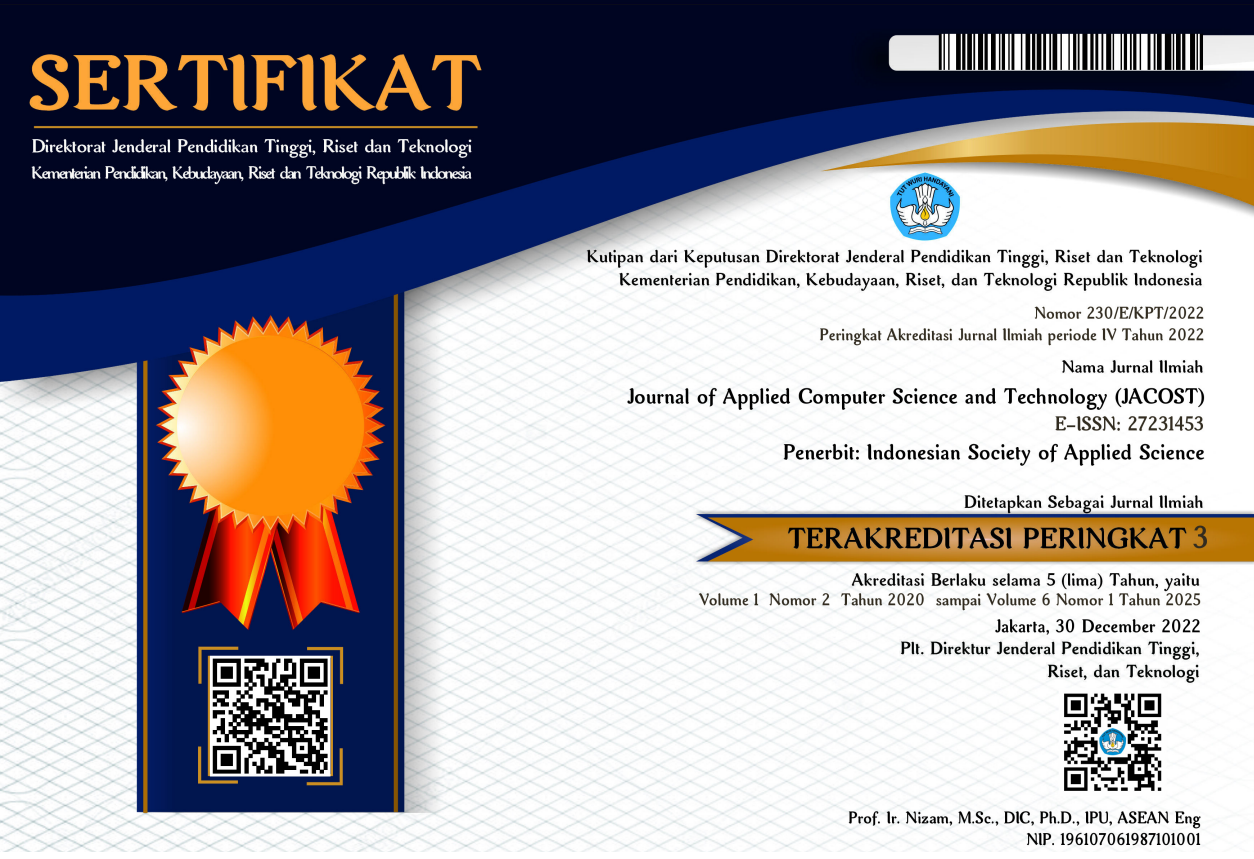Sistem Pakar Mendiagnosa Gangguan Mental pada Diri Seseorang Mengunakan Metode Certainty Factor
DOI:
https://doi.org/10.52158/jacost.v3i1.307Keywords:
Expert System, Certainty Factor, Mental Disorder, Forward, PHP, MySqlAbstract
People with mental disorders are very much starting in Indonesia, the results of health research in 2015, 1,193,151 people or 0.467% of the population who suffer from mental disorders. This mental disorder disease should not be silenced anymore, must be followed up or minimized in order to improve health conditions in Indonesia. The poverty rate in Indonesia until now is still relatively high and makes it difficult for people to deal with mental disorders. As for minimizing the handling of this mental disorder, it is very suitable to build an expert system using the certainty factor method, which is a method that defines a measure of capacity for a fact or rule, in expressing the level of confidence of an expert on a problem that is being faced by a patient or sufferer and can also be used as a benchmark of the results of the diagnosis of a disease suffered. By making this expert system, it can be useful for many people and can know clearly about mental disorders from symptoms and solutions based on a website and using PHP programming with a MySQL database. The results of the study using the certainty factor method with tests that have been carried out by the user or users are that the type of mental disorder suffered is the type of schizophrenia with a 56% certainty rate.
Downloads
References
Sudarmana, L., & Lestari, F. (2018). Aplikasi Sistem Pakar Untuk mendiagnosis Gangguan Jiwa Schizophrenia. 3(1), 40–44, ISSN: 2477-5126, e-ISSN: 2548-9356, Dec. 2020.
Efendi, Fauzi, A., & kusumaningrum, D. S. (2020) “Diagnosa Penyakit Gangguan Jiwa Menggunakan Metode Certainty Factor”, Scientific Student Journal For Information, Technology and science, vol. 1, no. 1, pp. 7 – 11, ISSN: 2715-2766.
Efendi, I., Niswatin, R. K., & Farida, I. N. (2020). Penerapan Metode Certainty Factor untuk Sistem Pakar Diagnosa Penyakit Burung Puyuh Berbasis Web. e-ISSN: 2549-7952, p-ISSN: 2580-3336.
Utami, F. N., Satoto, K. I., Martono, K. T., Studi, P., Komputer, S., Teknik, F., & Diponegoro, U. (2017). Rancang Bangun Aplikasi Sistem Pakar Diagnosis Gangguan Emosional Pada Anak Berbasis Aplikasi Website. 4(1), 109–123, e-ISSN: 2338-0403.
Deslianti, D., & Pahrizal. (2020). Penerapan Metode Certainty Factor Dalam Mendiagnosa Penyakit Pada Mata Manusia. 3(4), p-ISSN: 2655-755X.
Rachman, R., & Mukminin, A. (2018) tentang penerapan metode certainty factor pada sistem pakar penentuan minat dan bakat siswa sd. 4(2), ISSN: 2621-038X, p-ISSN: 2580-3336.
Girsang, R. R., & Fahmi, H. (2019). Sistem Pakar Mendiagnosa Penyakit Mata Katarak Dengan Metode Certainty Factor Berbasis Web. 11(1), 27-31, p-ISSN : 1978-161X, e-ISSN : 2477-2550, Doi : 10.18860/mat.v11i1.7673.
Waruwu, R. T., & Sindar, A. (2020). Sistem Pakar Menentukan Jenis Gangguan Perkembangan Anak Menggunakan Metode Certainty Factor. 1(2), 1-4, e-ISSN : 2714-8661.
Pramana, D., Ramadhan, P. S., Elfitriani. (2021). Sistem Pakar Untuk Mendiagnosa Penyakit Covid-19 Dengan Menggunakan Metode Certainty Factor. 1(2), pp. 104-114, p-ISSN : 9800-3456, e-ISSN : 2675-9802.
Andriansyah, D., & Nulhakim, L. (2021). Expert System For Diagnose Covid19 Using Certainty Factor Method. 5(1), pp. 11-20, p-ISSN : 2549-6247, e-ISSN : 2549-6255, Doi : 10.31289/jite.v5i1.5069
Downloads
Published
Issue
Section
License
Pernyataan Hak Cipta dan Lisensi
Dengan mengirimkan manuskrip ke Journal of Applied Computer Science and Technology (JACOST), penulis setuju dengan kebijakan ini. Tidak diperlukan persetujuan dokumen khusus.
- Hak cipta pada setiap artikel adalah milik penulis.
- Penulis mempertahankan semua hak mereka atas karya yang diterbitkan, tak terbatas pada hak-hak yang diatur dalam laman ini.
- Penulis mengakui bahwa Journal of Applied Computer Science and Technology (JACOST) sebagai yang pertama kali mempublikasikan dengan lisensi Creative Commons Atribusi 4.0 Internasional (CC BY-SA).
- Penulis dapat memasukan tulisan secara terpisah, mengatur distribusi non-ekskulif dari naskah yang telah terbit di jurnal ini kedalam versi yang lain (misal: dikirim ke respository institusi penulis, publikasi kedalam buku, dll), dengan mengakui bahwa naskah telah terbit pertama kali pada Journal of Applied Computer Science and Technology (JACOST);
- Penulis menjamin bahwa artikel asli, ditulis oleh penulis yang disebutkan, belum pernah dipublikasikan sebelumnya, tidak mengandung pernyataan yang melanggar hukum, tidak melanggar hak orang lain, tunduk pada hak cipta yang secara eksklusif dipegang oleh penulis.
- Jika artikel dipersiapkan bersama oleh lebih dari satu penulis, setiap penulis yang mengirimkan naskah menjamin bahwa dia telah diberi wewenang oleh semua penulis bersama untuk menyetujui hak cipta dan pemberitahuan lisensi (perjanjian) atas nama mereka, dan setuju untuk memberi tahu rekan penulis persyaratan kebijakan ini. Journal of Applied Computer Science and Technology (JACOST) tidak akan dimintai pertanggungjawaban atas apa pun yang mungkin timbul karena perselisihan internal penulis.
Lisensi :
Journal of Applied Computer Science and Technology (JACOST) diterbitkan berdasarkan ketentuan Lisensi Creative Commons Atribusi 4.0 Internasional (CC BY-SA). Lisensi ini mengizinkan setiap orang untuk :.
- Berbagi — menyalin dan menyebarluaskan kembali materi ini dalam bentuk atau format apapun;
- Adaptasi — menggubah, mengubah, dan membuat turunan dari materi ini untuk kepentingan apapun.
Lisensi :
-
Atribusi — Anda harus mencantumkan nama yang sesuai, mencantumkan tautan terhadap lisensi, dan menyatakan bahwa telah ada perubahan yang dilakukan. Anda dapat melakukan hal ini dengan cara yang sesuai, namun tidak mengisyaratkan bahwa pemberi lisensi mendukung Anda atau penggunaan Anda.
-
BerbagiSerupa — Apabila Anda menggubah, mengubah, atau membuat turunan dari materi ini, Anda harus menyebarluaskan kontribusi Anda di bawah lisensi yang sama dengan materi asli.

















